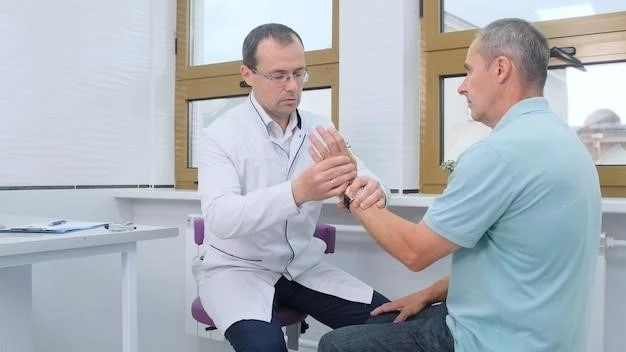Article Plan⁚ Disease ⏤ Osteoarthritis
Overview of Osteoarthritis
Osteoarthritis (OA) is a degenerative joint disease that affects millions worldwide. It causes discomfort, stiffness, and inflammation in the joints, often worsening with age. Joint cartilage wear and tear, resulting in pain and decreased mobility, characterize OA. Common in hands, knees, hips, and spine, it leads to joint breakdown over time. Regular exercise, including muscle strengthening and fitness improvement, is vital in managing OA. Supplements and medications can help alleviate joint pain. Understanding the stages of OA, from mild to severe, enables proper treatment planning. Consult healthcare providers for the best approach to manage osteoarthritis.
Causes of Osteoarthritis
Osteoarthritis (OA) is primarily caused by the gradual breakdown of joint cartilage over time, leading to pain, stiffness, and reduced joint mobility. Factors such as aging, genetic predisposition, joint injuries, obesity, and overuse of joints contribute to the development of OA. Wear and tear on the joints due to repetitive stress or mechanical issues can accelerate cartilage deterioration. Understanding these causes can help individuals take preventive measures and manage the condition effectively.
Symptoms of Osteoarthritis
Osteoarthritis typically presents with joint pain, stiffness, and swelling. Individuals may also experience reduced range of motion and joint tenderness. Common symptoms include crepitus (a grating sensation in the joint), bone spurs, and joint instability. As osteoarthritis progresses, symptoms may worsen, impacting daily activities. Understanding these signs can aid in early diagnosis and prompt management of the condition. Consult with healthcare professionals if you experience persistent joint discomfort.
Diagnosis of Osteoarthritis

Diagnosing osteoarthritis typically involves a combination of medical history review, physical examination, and imaging tests like X-rays or MRIs. Healthcare providers assess symptoms, joint function, and conduct tests to rule out other conditions. Blood tests may be done to identify markers of inflammation. An accurate diagnosis is crucial for developing a tailored treatment plan. Seeking medical attention early can help manage symptoms effectively and improve long-term joint health;
Treatment Options for Osteoarthritis
Exercise plays a crucial role in managing osteoarthritis by improving joint function and reducing pain. Strengthening exercises help support the joints, while aerobic activities boost overall fitness levels. In addition to physical activity, weight management is vital to alleviate stress on the joints. Medications like analgesics and nonsteroidal anti-inflammatory drugs (NSAIDs) can help manage pain and inflammation. Surgical interventions, like joint replacement, may be necessary in severe cases. Consult healthcare professionals to explore various treatment options tailored to your condition.
Lifestyle Changes to Manage Osteoarthritis
Living with osteoarthritis involves adopting lifestyle modifications to alleviate joint pain and improve overall well-being. Maintaining a healthy weight reduces strain on joints, while a balanced diet rich in nutrients may aid in managing inflammation. Engage in regular physical activity to strengthen muscles and improve joint flexibility. Implement ergonomic changes at home and work to minimize joint stress. Practicing relaxation techniques can help manage stress, which can exacerbate symptoms. Consult healthcare professionals for personalized lifestyle recommendations to effectively manage osteoarthritis.
Importance of Exercise in Osteoarthritis

Exercise plays a vital role in managing osteoarthritis by enhancing joint flexibility, strengthening muscles, and reducing pain. Incorporating a combination of exercises that focus on muscle strengthening and overall fitness can help improve joint function and mobility. Regardless of age or fitness level, regular physical activity is essential in effectively managing osteoarthritis symptoms. Consult healthcare professionals to develop a personalized exercise plan that suits your needs and supports joint health.
Medications for Osteoarthritis
Medications play a crucial role in managing osteoarthritis symptoms by reducing pain and inflammation. Common medications for osteoarthritis include analgesics like acetaminophen, nonsteroidal anti-inflammatory drugs (NSAIDs) such as ibuprofen, and topical creams or patches for localized relief. In severe cases, corticosteroid injections may be recommended to alleviate joint discomfort. It is essential to consult healthcare providers before starting any medication regimen to ensure proper dosage and minimize potential side effects.
Surgical Interventions for Osteoarthritis
Surgical interventions for osteoarthritis are typically considered when other treatments have not provided sufficient relief. Common surgeries for osteoarthritis include joint replacement procedures such as hip or knee replacements. These surgeries aim to alleviate pain, improve joint function, and enhance quality of life. Arthroscopic procedures, like debridement or lavage, may also be performed to address joint damage. It is crucial to discuss the potential risks and benefits of surgical interventions with healthcare providers to make informed decisions about managing osteoarthritis.
Alternative Therapies for Osteoarthritis
Alternative therapies can complement traditional treatment approaches in managing osteoarthritis symptoms. Options like acupuncture, massage therapy, and chiropractic care may provide additional relief from pain and stiffness. Supplements such as glucosamine and chondroitin are popular choices for promoting joint health. Heat and cold therapy, as well as herbal remedies like turmeric, are also commonly used to alleviate discomfort. When considering alternative therapies, consult healthcare providers to ensure they align with your overall treatment plan and goals.
Managing Osteoarthritis Pain
Managing osteoarthritis pain is crucial in improving quality of life for individuals affected by this condition. It involves a combination of treatments, including medications, exercise, lifestyle modifications, and alternative therapies. By staying active, maintaining a healthy weight, and incorporating pain-relief strategies, individuals can effectively alleviate joint discomfort. Consulting with healthcare providers to develop a personalized pain management plan is essential in addressing the unique needs of each person living with osteoarthritis.
Osteoarthritis in Different Joints (Knees٫ Hips٫ Hands)
Osteoarthritis can affect various joints in the body, commonly impacting the knees, hips, and hands. In the knees, osteoarthritis can lead to pain, swelling, and decreased range of motion. Hip osteoarthritis may cause discomfort in the groin, thigh, or buttocks, with stiffness and difficulty walking. Hand osteoarthritis can result in joint pain, stiffness, and swelling, affecting grip strength and dexterity. Understanding how osteoarthritis manifests in different joints can guide tailored treatment approaches. Consulting healthcare providers can help address specific joint-related concerns.
Progression and Stages of Osteoarthritis
Osteoarthritis progresses through different stages, starting with the mild wear and tear of joint cartilage and advancing to severe joint damage. The stages of osteoarthritis typically include initial cartilage degeneration, increased joint pain and stiffness, formation of bone spurs, and possible joint deformity. Understanding the progression of osteoarthritis is essential for early detection and appropriate management strategies. Healthcare providers can help diagnose the stage of osteoarthritis and recommend personalized treatments based on the severity of the condition.
Strategies for Preventing Osteoarthritis
Preventing osteoarthritis involves adopting healthy lifestyle habits and minimizing risk factors. Maintaining a healthy weight reduces stress on joints, decreasing the likelihood of joint wear and tear. Engaging in regular exercise helps strengthen muscles and improve joint flexibility, enhancing joint health. Protecting joints from injury through proper body mechanics and ergonomic practices can prevent osteoarthritis onset. Additionally, managing underlying conditions like diabetes and obesity may reduce the risk of developing osteoarthritis. Consult healthcare professionals for personalized strategies to prevent osteoarthritis and promote overall joint health.
